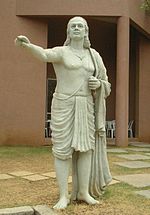Āryabhaṭa
From Vigyanwiki
Āryabhaṭa (476–550 CE) [1]was an Indian mathematician and astronomer of the classical age
Āryabhaṭa | |
|---|---|
 | |
| जन्म | 476 CE Kusumapura (Pataliputra) |
| मर गया | 550 CE Pataliputra |
| युग | Gupta Era |
| उल्लेखनीय कार्य | Āryabhaṭīya, Arya-siddhanta |
of Indian mathematics and Indian astronomy. He flourished in the Gupta Era[2] and produced works such as the Āryabhaṭīya (which mentions that in 3600 Kali Yuga, 499 CE, he was 23 years old) and the Ārya-siddhānta[3].
His pure mathematics discusses topics such as determination of square and cube roots, geometrical figures with their properties and mensuration, arithmetic progression problems on the shadow of the gnomon, quadratic equations, linear and indeterminate equations. Āryabhaṭa calculated the value of pi (π) 3.1416 to the fourth decimal digit. Scholars consider him to be one of the pillars of Indian astronomy and mathematics.[4]
See Also
External Links
References
- ↑ "Āryabhaṭa".
- ↑ "Achievements of the Gupta Empire".
- ↑ "Āryabhaṭa".
- ↑ A Primer to Bhāratīya Gaṇitam , Bhāratīya-Gaṇita-Praveśa- Part-1. Samskrit Promotion Foundation. 2021. ISBN 978-81-951757-2-7.